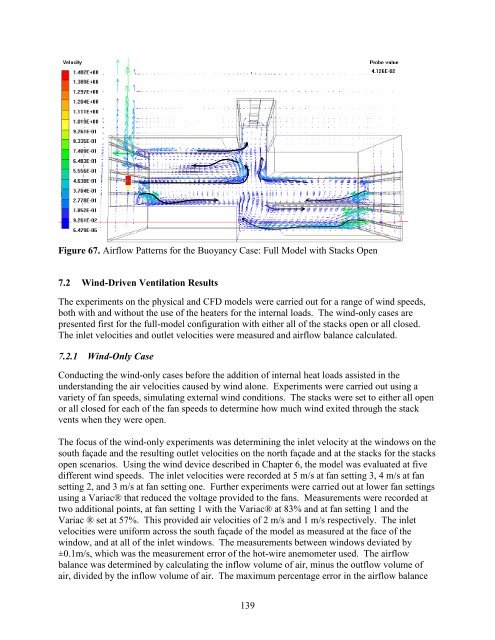Methodology for the Evaluation of Natural Ventilation in ... - Cham
Methodology for the Evaluation of Natural Ventilation in ... - Cham
Methodology for the Evaluation of Natural Ventilation in ... - Cham
You also want an ePaper? Increase the reach of your titles
YUMPU automatically turns print PDFs into web optimized ePapers that Google loves.
Figure 67. Airflow Patterns <strong>for</strong> <strong>the</strong> Buoyancy Case: Full Model with Stacks Open7.2 W<strong>in</strong>d-Driven <strong>Ventilation</strong> ResultsThe experiments on <strong>the</strong> physical and CFD models were carried out <strong>for</strong> a range <strong>of</strong> w<strong>in</strong>d speeds,both with and without <strong>the</strong> use <strong>of</strong> <strong>the</strong> heaters <strong>for</strong> <strong>the</strong> <strong>in</strong>ternal loads. The w<strong>in</strong>d-only cases arepresented first <strong>for</strong> <strong>the</strong> full-model configuration with ei<strong>the</strong>r all <strong>of</strong> <strong>the</strong> stacks open or all closed.The <strong>in</strong>let velocities and outlet velocities were measured and airflow balance calculated.7.2.1 W<strong>in</strong>d-Only CaseConduct<strong>in</strong>g <strong>the</strong> w<strong>in</strong>d-only cases be<strong>for</strong>e <strong>the</strong> addition <strong>of</strong> <strong>in</strong>ternal heat loads assisted <strong>in</strong> <strong>the</strong>understand<strong>in</strong>g <strong>the</strong> air velocities caused by w<strong>in</strong>d alone. Experiments were carried out us<strong>in</strong>g avariety <strong>of</strong> fan speeds, simulat<strong>in</strong>g external w<strong>in</strong>d conditions. The stacks were set to ei<strong>the</strong>r all openor all closed <strong>for</strong> each <strong>of</strong> <strong>the</strong> fan speeds to determ<strong>in</strong>e how much w<strong>in</strong>d exited through <strong>the</strong> stackvents when <strong>the</strong>y were open.The focus <strong>of</strong> <strong>the</strong> w<strong>in</strong>d-only experiments was determ<strong>in</strong><strong>in</strong>g <strong>the</strong> <strong>in</strong>let velocity at <strong>the</strong> w<strong>in</strong>dows on <strong>the</strong>south façade and <strong>the</strong> result<strong>in</strong>g outlet velocities on <strong>the</strong> north façade and at <strong>the</strong> stacks <strong>for</strong> <strong>the</strong> stacksopen scenarios. Us<strong>in</strong>g <strong>the</strong> w<strong>in</strong>d device described <strong>in</strong> Chapter 6, <strong>the</strong> model was evaluated at fivedifferent w<strong>in</strong>d speeds. The <strong>in</strong>let velocities were recorded at 5 m/s at fan sett<strong>in</strong>g 3, 4 m/s at fansett<strong>in</strong>g 2, and 3 m/s at fan sett<strong>in</strong>g one. Fur<strong>the</strong>r experiments were carried out at lower fan sett<strong>in</strong>gsus<strong>in</strong>g a Variac® that reduced <strong>the</strong> voltage provided to <strong>the</strong> fans. Measurements were recorded attwo additional po<strong>in</strong>ts, at fan sett<strong>in</strong>g 1 with <strong>the</strong> Variac® at 83% and at fan sett<strong>in</strong>g 1 and <strong>the</strong>Variac ® set at 57%. This provided air velocities <strong>of</strong> 2 m/s and 1 m/s respectively. The <strong>in</strong>letvelocities were uni<strong>for</strong>m across <strong>the</strong> south façade <strong>of</strong> <strong>the</strong> model as measured at <strong>the</strong> face <strong>of</strong> <strong>the</strong>w<strong>in</strong>dow, and at all <strong>of</strong> <strong>the</strong> <strong>in</strong>let w<strong>in</strong>dows. The measurements between w<strong>in</strong>dows deviated by±0.1m/s, which was <strong>the</strong> measurement error <strong>of</strong> <strong>the</strong> hot-wire anemometer used. The airflowbalance was determ<strong>in</strong>ed by calculat<strong>in</strong>g <strong>the</strong> <strong>in</strong>flow volume <strong>of</strong> air, m<strong>in</strong>us <strong>the</strong> outflow volume <strong>of</strong>air, divided by <strong>the</strong> <strong>in</strong>flow volume <strong>of</strong> air. The maximum percentage error <strong>in</strong> <strong>the</strong> airflow balance139
















